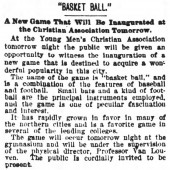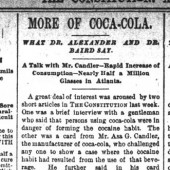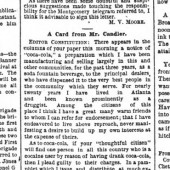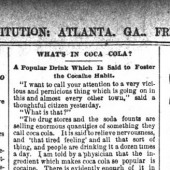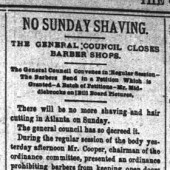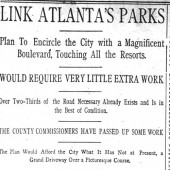 The Constitution: Atlanta, Ga. Sunday, February 2, 1896.
The Constitution: Atlanta, Ga. Sunday, February 2, 1896.
Plan To Encircle the City with a Magnificent Boulevard, Touching All the Resorts.
WOULD REQUIRE VERY LITTLE EXTRA WORK
Over Two-Thirds of the Road Necessary Already Exists and Is in the Best of Condition.
THE COUNTY COMMISSIONERS HAVE PASSED UP SOME WORK
The Plan Would Afford the City What It Has Not at Present, a Grand Driveway Over a Picturesque Course.
Atlanta, a city of drivers, driving clubs, mettlesome teams, glossy turnouts and inviting suburbs, is almost without drives.
The city is environed with lovely scenery. Fresh hills of green, softly carpeted fields and cool, inviting valleys begirt the city. Nature has done her best to please the eye. Her canvas is perfect. And our people have done much to improve it in the way of development. Beautiful homes have been set about in pretty nooks, just close enough to the city to enjoy its benefits and far enough away to escape its smoke, its dust and its disagreeable features. These homes are delightful to live in and charming to look upon, and there is but one objectionable feature connected with them. There are no smooth, inviting drives leading to them.
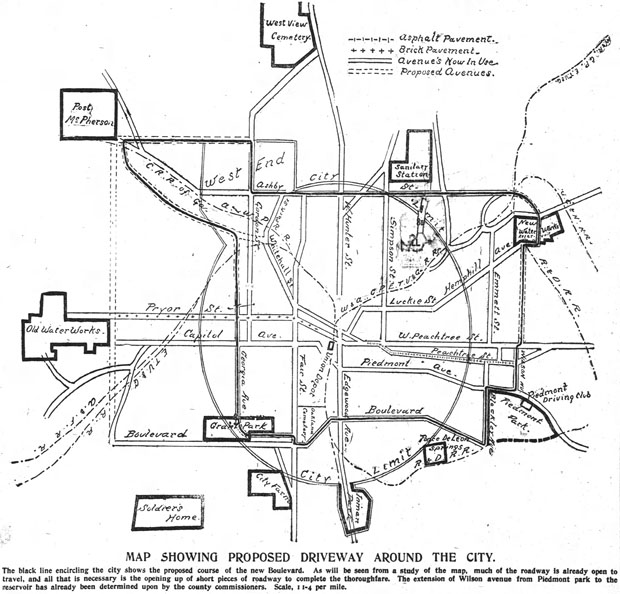
Yet all around the city, forming almost a complete circle, are bits and pieces of excellent roads which, with a little work, could be linked together, forming a magnificent driveway about the city and touching all the lovely points.
Not only would this splendid chain of boulevards encircle the city and form one of the most beautiful and magnificent drives to be found in the south, but it would link together the pretty parks that stand on every side of the city.
The city is environed with inviting breathing spots—places where nature has been lavish with her gifts and where beautiful scenery and landscape have reveled. To the northeast is Piedmont park, with its hills, its groves, its lovely buildings, its beautiful lake and splendid surroundings. It is connected with the heart of the city by Peachtree street, a direct route, which, with its splendid asphalt and chert, forms one of the very few select drives in the city or about it.
Peachtree street is all that could be asked of it in the way of beauty and improvement, yet on pretty afternoons when the air is full of tonic and the sun shins caressingly it is too greatly crowded to admit of any sort of comfort. Elegant equipages bowling along almost choke up passage and frequently traffic is impeded. The crowded condition of this, the city’s choicest drive, argues the crying need of more good thoroughfares suitable for driving.
It is just a step from Piedmont park to Grant park, but so poorly are the streets laid out that it never occurs to any one to take in the two parks in an afternoon’s drive, and yet it could easily be done with just a little work. The broad boulevard which stretches along the eastern limit of the city is an almost direct route from Piedmont park to Grant park. It touches Piedmont park on the eastern margin and stretches away to the south, running along the eastern side of Grant park. It is wide, well paved all the way and traverses a beautiful section of the city—a section that is just springing into life. New residences are going up all along the boulevard and new streets are being cut into it at regular intervals on the east and west.
Only a Slight Change Needed.
It is an almost direct line between the two parks, as stated, but it deflects slightly when the Georgia railroad and the Southern railroad are reached at Decatur street. North Boulevard cuts into the latter street just in front of the big bag factory of Elsas, May & Co. Owing to the physical nature of the ground hereabout it was impossible to effect a direct crossing and because of this fact the only deflection in the big, wide boulevard occurs here. It is not a serious objection by any means, however. The railroads can be easily crossed, the street skirting the eastern edge of Oakland can be opened out and put in condition and made to connect the North and South Boulevards. It will have to be improved a distance of about two blocks only to make the connection complete.
South Boulevard, which would thus be reached, is wide, spacious, well paved and marks a lovely course. It is but a short distance along it to Grant park and Little Switzerland. The route is a beautiful and inviting one and one that is always a pleasure to drive over.
The park reached, there are many circuitous drives winding through it that tempt the driver. The drive through Little Switzerland, the drive to McPherson’s monument, the drive around pretty Lake Abana and the many other shaded thoroughfares in the park offer a world of pleasure to the driver.
Leaving Grant park after coursing over as many of the beautiful drives within it boundaries as pleases the fancy of the driver, Georgia avenue affords a splendid outlet to the west. Here again is an unusually wide thoroughfare, well paved and leading from east to west through the southernmost part of the city. It goes in a direct line with scarcely a crook or turn. It is open straight through from Grant park to McDaniel street, which is within a block and a half of the East Tennessee railroad track.
A distance of one-fourth of a mile lies between the end of this avenue and the Whitehall street crossing at West End. The proposition to cut Georgia avenue through in this direction to a point from which connection with Whitehall street at the crossing could easily be made has frequently been discussed by the county commissioners. It is a small piece of work, and President Collier says that it would be a matter of small labor to open it through, thus connecting that part of the city west of the Tennessee railroad and West End with the eastern part of the city. This of itself would be an improvement that would be welcomed by all the residents in that vicinity.
This avenue opened, an easy outlet to West End would be afforded and the last year’s project of the county commissioners to construct a new fifty-foot road from a point just south of the Whitehall street railroad crossing to Fort McPherson would be an easy matter to carry out. For some months the county commissioners have worked on this favorite project. Their plan was to construct the road on the east side of the Central railroad and parallel to the railroad tracks to Fort McPherson. The route proposed is some distance from the railroad track and would be perfectly safe so far as trains frightening horses is concerned.
Right of Way Secured.
The route for this road was laid out early last year and it passed through a stretch of country that is perfectly beautiful. It is magnificently wooded and lovely new homes are dotted all about. The commissioners mapped out the route and went so far as to secure the right of way. They were successful in the latter point, securing the consent of all the property owners along the route for the construction of the road.
A more inviting route could not be found anywhere around the city. It is comparatively level, and with a little grading could be made into an ideal drive.
A driveway to Fort McPherson has long been wanted by those of our citizens who drive. The fort is quite a popular and interesting place with our people, and at present it can only be reached by the hilly dirt road that runs along the railroad track. The constantly passing trains render this very dangerous to drivers and the need of a driveway removed from the railroad track has long been felt. It was in recognition of this need that the county commissioners took up the matter. They laid out their route, and, as stated, secured the right of way, but for some unknown reason dropped the matter. It seems that all the commissioners favored the project and wanted to see the road built with comparatively little cost to the county. The grading was to be done by the county convicts, of course, and would have been a matter of ony a few weeks.
The plan of the commissioners contemplated a bridge over the railroad just north of Fort McPherson station, thus obviating the danger of grade crossing. This bridge would be erected almost in front of the entrance to the fort and would be highly convenient.
This part of the road can be constructed with little delay and trouble. It will meet a requirement which has long been felt and will afford the city a drive such as is to be found nowhere about the city at present.
Returning from the fort it is proposed to construct a road along the western side of the railroad tracks at about the same distance from the tracks as the road going out. This road, like the other, could be made with little expense. The country through which it would pass is very level and very little grading would be required. A delightful drive to West End would thus be formed. This road would terminate at Ashby street, which thoroughfare is already open to within short distance of the new waterworks reservoir park. Ashby street is a magnificent drive, covering a distance of about two miles to the reservoir and passing through all the picturesque section on the west of the city. Much that would be new and interesting to our people would be presented by a spin over this new thoroughfare, which is already in condition for travel.
An Attractive Resort.
The new waterworks reservoir park is one of the most attractive points for drives around the city. With a little expenditure of money this could be made one of the most beautiful parks in the south. Its natural advantages are unsurpassed. In summer it is ideal. It is walled in with lovely hills, crested with green trees and the picture is one that enchants the eye. In summer it is a favorite drive with our people, although little or nothing has been done to beautify it or make it attractive. With Ashby street opened through to the reservoir, its popularity would equal that of any drive in the state. Ashby street is already opened within a third of a mile of the reservoir and but little work would be required to complete the avenue to the big pond.
From the reservoir to Piedmont park is but a step and the connection could be easily made. The distance is about a mile, and already a route between the two points has been proposed. Those who have considered the matter propose to extend Wilson avenue directly through to the reservoir. The route is direct and has already been surveyed.
The county commissioners took up the matter several weeks ago. At that time they decided to make the extension at once and the work was passed up by the commissioners and ordered done. It is among the improvements of the near future and will be made as soon as the county convicts can reach it.
The improvement will be a great boon to the city’s drives. It will open up a direct avenue from the reservoir to the entrance to Piedmont park. It will be a favorite drive with the members of the driving club. It is convenient to them and will offer many attractions delightful to the driver.
Complete Circuit of the City.
This completes the circuit of the city, presenting a continuous boulevard around the city, touching at all attractive points. Starting at Piedmont park, a spot frequented by all Atlantans and where the driving club is located, it passes Ponce de Leon, Grant park, Little Switzerland, Fort McPherson, West End, Waterworks park, returning to Piedmont park, the starting point. This makes a drive of about eleven miles in length and presents a spectacle of beautiful and varied scenery, as grand as can be furnished anywhere in the city. This reform could be accomplished with little work. Two-thirds of the road is already in existence, and all that is needed is the building of some short bits of road to connect the boulevard already open to travel. The county commissioners could do the work with convicts and the cost would be merely nominal. It would be, too, but a matter of a short time. There are 227 convicts in the county’s service and it would take them but a few weeks to make the connections proposed. Compared to the great benefits that would be derived, the cost is nothing.
The two drives would not be the only ones to reap the benefit from the extension of the roads suggested. It would link the city’s parks together and afford easy access from one to the other for all the people. The wheelmen wold also be great gainers by the change. It would be a pleasant spurt for them to encircle the city in a morning’s or late afternoon’s ride.
The accompanying map shows the proposed route of the park boulevard. It will be seen at a glance that it makes a complete circuit of the city and leaves out no point of interest on the way. The route is replete with interest and presents many attractions. It will also be seen that with a little work Atlanta might have a magnificnet drive by cutting the city in half. Peachtree and Pryor streets with their pavements of vitrified brick and asphalt and chert extend through the city from one side to the other, passing right through the heart of the town. For over a mile beyond Wilson avenue Peachtree has been paved with chert. This gives a smooth drive of about three miles from the utmost limit of the chert to the Capital City club. To continue this paving through to the point where the vitrified brick paving begins on Pryor street would be but natural and desirable. Only about six blocks would have to be paved to connect the two. Then an unbroken drive of over seven miles would be presented. Pryor street has been opened by the county commissioners to within two hundred yards of the old waterworks property and the drive is a beautiful and picturesque one.
A Spin Around Town.
A spin from the point on Peachtree to the old waterworks property, over a surface of chert, asphalt and vitrified brick would be a godsend to our drivers. Some day this will be possible; in fact, there is already a strong feeling in favor of the paving of the short space that divides the good paving on the two streets.
City Engineer Clayton has long been a hearty advocate of the plan to circle the city about with a continuous boulevard. He has made a study of the question and states that it could be done by the county convicts with little cost. He knows the topography of the country thoroughly and is well acquainted with the difficulties that would be encountered. When he was asked about the project he expressed himself as being in favor of it.
“With the boulevard built around the city,” he said, “our system of parks and boulevards would be equal to that of Chicago. Very few of our citizens realize what splendid advantages we have in the way of parks. With the expenditure of a little money and care our parks could be magnificently developed. I am in favor of the boulevard about the city and hope to see it constructed.”
President Collier, of the county commissioners, was most favorable impressed with the proposition when it was presented to him.
He said it seemed altogether feasible and could be done by the county convicts. He talked at length on the proposition, and was inclined to believe that it would be a great thing for the city, county and the driving public.
